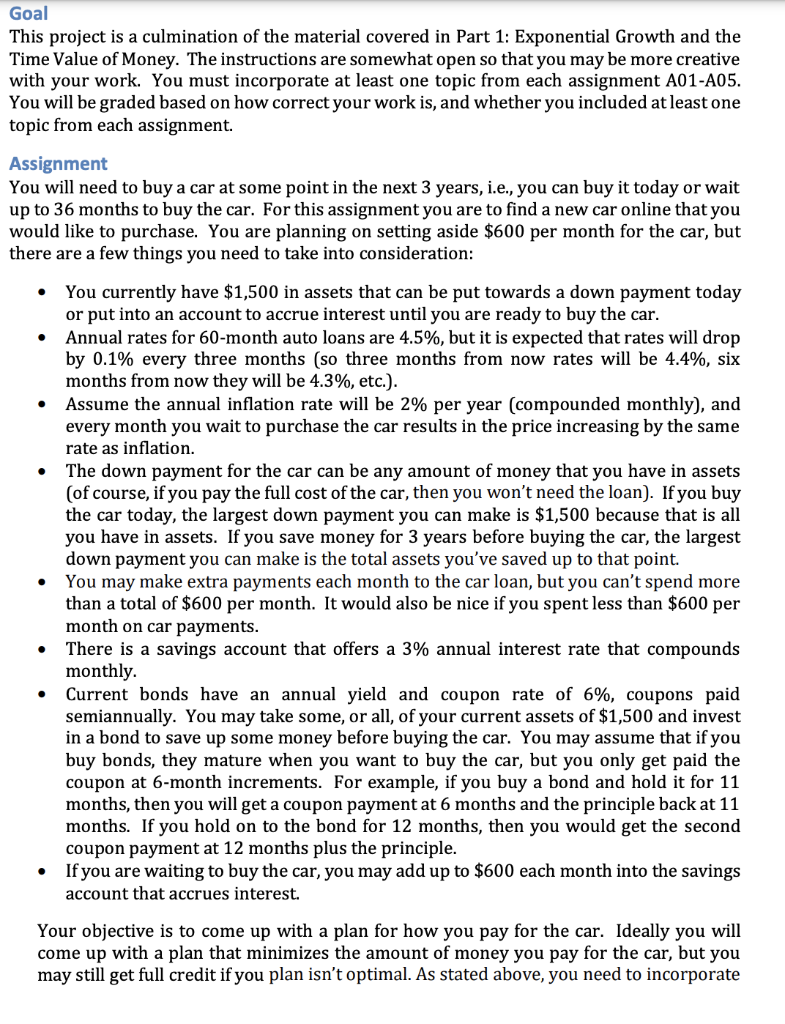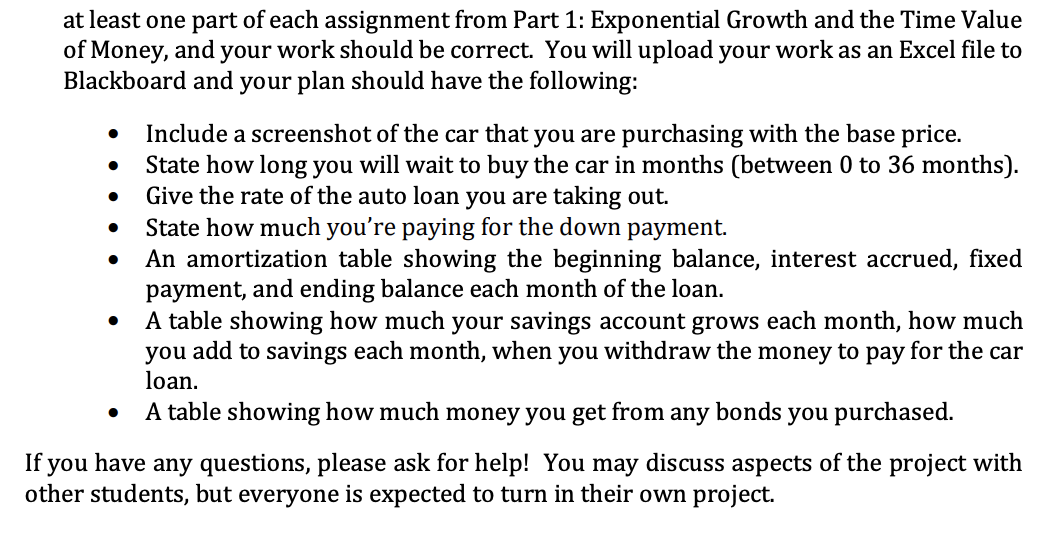

Goal This project is a culmination of the material covered in Part 1: Exponential Growth and the Time Value of Money. The instructions are somewhat open so that you may be more creative with your work. You must incorporate at least one topic from each assignment A01-A05. You will be graded based on how correct your work is, and whether you included at least one topic from each assignment. . Assignment You will need to buy a car at some point in the next 3 years, i.e., you can buy it today or wait up to 36 months to buy the car. For this assignment you are to find a new car online that you would like to purchase. You are planning on setting aside $600 per month for the car, but there are a few things you need to take into consideration: You currently have $1,500 in assets that can be put towards a down payment today or put into an account to accrue interest until you are ready to buy the car. Annual rates for 60-month auto loans are 4.5%, but it is expected that rates will drop by 0.1% every three months (so three months from now rates will be 4.4%, six months from now they will be 4.3%, etc.). Assume the annual inflation rate will be 2% per year (compounded monthly), and every month you wait to purchase the car results in the price increasing by the same rate as inflation. The down payment for the car can be any amount of money that you have in assets (of course, if you pay the full cost of the car, then you won't need the loan). If you buy the car today, the largest down payment you can make is $1,500 because that is all you have in assets. If you save money for 3 years before buying the car, the largest down payment you can make is the total assets you've saved up to that point. You may make extra payments each month to the car loan, but you can't spend more than a total of $600 per month. It would also be nice if you spent less than $600 per month on car payments. There is a savings account that offers a 3% annual interest rate that compounds monthly. Current bonds have an annual yield and coupon rate of 6%, coupons paid semiannually. You may take some, or all, of your current assets of $1,500 and invest in a bond to save up some money before buying the car. You may assume that if you buy bonds, they mature when you want to buy the car, but you only get paid the coupon at 6-month increments. For example, if you buy a bond and hold it for 11 months, then you will get a coupon payment at 6 months and the principle back at 11 months. If you hold on to the bond for 12 months, then you would get the second coupon payment at 12 months plus the principle. If you are waiting to buy the car, you may add up to $600 each month into the savings account that accrues interest. . . Your objective is to come up with a plan for how you pay for the car. Ideally you will come up with a plan that minimizes the amount of money you pay for the car, but you may still get full credit if you plan isn't optimal. As stated above, you need to incorporate at least one part of each assignment from Part 1: Exponential Growth and the Time Value of Money, and your work should be correct. You will upload your work as an Excel file to Blackboard and your plan should have the following: Include a screenshot of the car that you are purchasing with the base price. State how long you will wait to buy the car in months (between 0 to 36 months). Give the rate of the auto loan you are taking out. State how much you're paying for the down payment. An amortization table showing the beginning balance, interest accrued, fixed payment, and ending balance each month of the loan. A table showing how much your savings account grows each month, how much you add to savings each month, when you withdraw the money to pay for the car loan. A table showing how much money you get from any bonds you purchased. If you have any questions, please ask for help! You may discuss aspects of the project with other students, but everyone is expected to turn in their own project. Goal This project is a culmination of the material covered in Part 1: Exponential Growth and the Time Value of Money. The instructions are somewhat open so that you may be more creative with your work. You must incorporate at least one topic from each assignment A01-A05. You will be graded based on how correct your work is, and whether you included at least one topic from each assignment. . Assignment You will need to buy a car at some point in the next 3 years, i.e., you can buy it today or wait up to 36 months to buy the car. For this assignment you are to find a new car online that you would like to purchase. You are planning on setting aside $600 per month for the car, but there are a few things you need to take into consideration: You currently have $1,500 in assets that can be put towards a down payment today or put into an account to accrue interest until you are ready to buy the car. Annual rates for 60-month auto loans are 4.5%, but it is expected that rates will drop by 0.1% every three months (so three months from now rates will be 4.4%, six months from now they will be 4.3%, etc.). Assume the annual inflation rate will be 2% per year (compounded monthly), and every month you wait to purchase the car results in the price increasing by the same rate as inflation. The down payment for the car can be any amount of money that you have in assets (of course, if you pay the full cost of the car, then you won't need the loan). If you buy the car today, the largest down payment you can make is $1,500 because that is all you have in assets. If you save money for 3 years before buying the car, the largest down payment you can make is the total assets you've saved up to that point. You may make extra payments each month to the car loan, but you can't spend more than a total of $600 per month. It would also be nice if you spent less than $600 per month on car payments. There is a savings account that offers a 3% annual interest rate that compounds monthly. Current bonds have an annual yield and coupon rate of 6%, coupons paid semiannually. You may take some, or all, of your current assets of $1,500 and invest in a bond to save up some money before buying the car. You may assume that if you buy bonds, they mature when you want to buy the car, but you only get paid the coupon at 6-month increments. For example, if you buy a bond and hold it for 11 months, then you will get a coupon payment at 6 months and the principle back at 11 months. If you hold on to the bond for 12 months, then you would get the second coupon payment at 12 months plus the principle. If you are waiting to buy the car, you may add up to $600 each month into the savings account that accrues interest. . . Your objective is to come up with a plan for how you pay for the car. Ideally you will come up with a plan that minimizes the amount of money you pay for the car, but you may still get full credit if you plan isn't optimal. As stated above, you need to incorporate at least one part of each assignment from Part 1: Exponential Growth and the Time Value of Money, and your work should be correct. You will upload your work as an Excel file to Blackboard and your plan should have the following: Include a screenshot of the car that you are purchasing with the base price. State how long you will wait to buy the car in months (between 0 to 36 months). Give the rate of the auto loan you are taking out. State how much you're paying for the down payment. An amortization table showing the beginning balance, interest accrued, fixed payment, and ending balance each month of the loan. A table showing how much your savings account grows each month, how much you add to savings each month, when you withdraw the money to pay for the car loan. A table showing how much money you get from any bonds you purchased. If you have any questions, please ask for help! You may discuss aspects of the project with other students, but everyone is expected to turn in their own project








